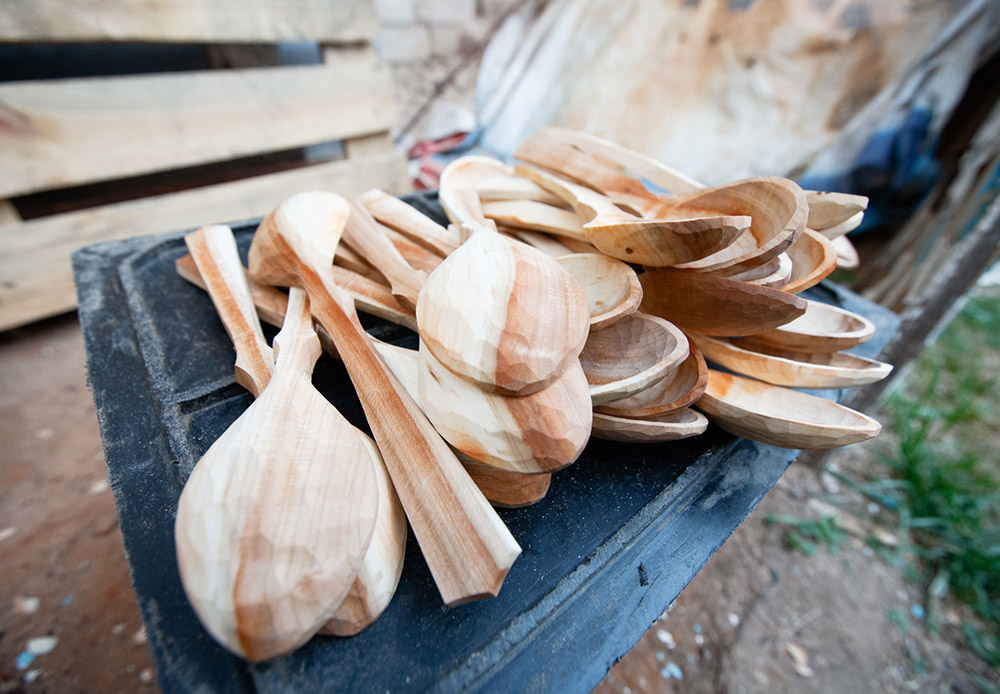How It’s Made: creating wooden spoons

The spoon is almost ready. Its handle can be decorated with an image or writing. For example, with a person's name or a Russian proverb. This part is a little tricky: in order for the writing to come out evenly, it has to be written from back to front, starting with the last letter and ending with the first.
Andrei Senushkin
It's hard to find a table utensil as irreplaceable as the spoon. In ancient Rus, spoons were used to eat, measure things, and to teach naughty children a lesson by giving them a good thwack on the forehead. Spoons could also be used for decoration and as a musical instrument!
Andrei Senushkin
In times of old, spoons in Rus and Scandinavian countries were made from wood. The small city of Semyonov in the Nizhny Novgorod region (approximately 415 kilometers from Moscow) was the capital of the Russian spoon trade.
Andrei Senushkin
At the end of the 19th century, around 7 thousand people made spoons in the Semyonovsky district, producing over 3 million spoons a year (roughly one spoon per day per person).
Andrei Senushkin
The job of the lozhkar, or spoon-making specialist, is an ancient profession that is quite rare nowadays. It's known that the first silver spoons in ancient Russia were first cast in the year 998, when they were first mentioned in ancient literature. Leonid Khazov is an outstanding representative of this profession: he makes his living making spoons and wooden dishware.
Andrei Senushkin
The process of creating a spoon starts with selecting the source material: a log. The spoon is created from the unprocessed part of the log that a master then chops into smaller pieces of wood. One log tends to produce one spoon.
Andrei Senushkin
According to the master, any person can make a spoon as long as they have a knife and the desire. The raw materials needed can be found in practically any deciduous, or "leafy", tree. Dishware is most often made out of birch, aspen, maple, or fruit trees. Coniferous trees aren't suitable due to their sticky resin and characteristic scent. Birch is practically as durable as oak and lasts in spoon-form much longer. While oak cracks, birch doesn't.
Andrei Senushkin
Clutching the wood in a vise, Leonid carves the future spoon from the wood.
Andrei Senushkin
You can use a hatchet further on, while manually pressing the piece of wood into the shape of a spoon, or you can use an electric fretsaw. It's faster that way.
Andrei Senushkin
An apprentice can do all the work up to this stage. After another 10 minutes of fine tuning it with a knife, you have a perfectly good spoon to eat with. This is where the master steps in. The spoon shouldn't just be functional; it has to be beautiful, as well.
Andrei Senushkin
The handle is ready. All that remains is carving out the part of the spoon that will be used for scooping and ladling. The walls should be 3-4 millimeters thick. If it's thinner, the spoon will be lighter and more beautiful, but it will also be less practical.
Andrei Senushkin
The spoons are then sent to dry. They need 1-2 days to air-dry in the summer or , if it's winter-time, on top of an oven. That's just enough time for one part of the spoon to dry while a new part is being cut out.
Andrei Senushkin
Polishing can be done manually using sandpaper or by machine. In Scandanavian countries, a special kind of horsetail was used for polishing.
Andrei Senushkin
The spoon is almost ready. Its handle can be decorated with an image or writing. For example, with a person's name or a Russian proverb. This part is a little tricky: in order for the writing to come out evenly, it has to be written from back to front, starting with the last letter and ending with the first.
Andrei SenushkinAll rights reserved by Rossiyskaya Gazeta.
Subscribe
to our newsletter!
Get the week's best stories straight to your inbox